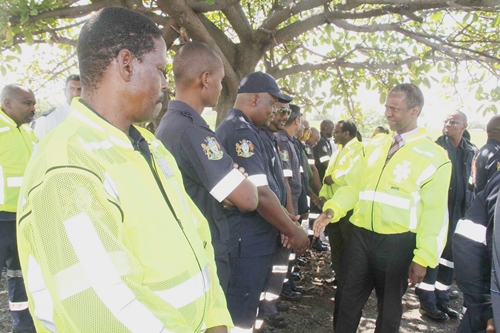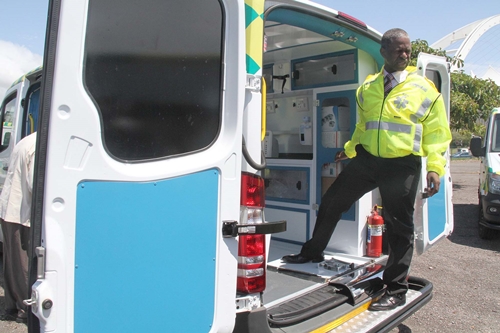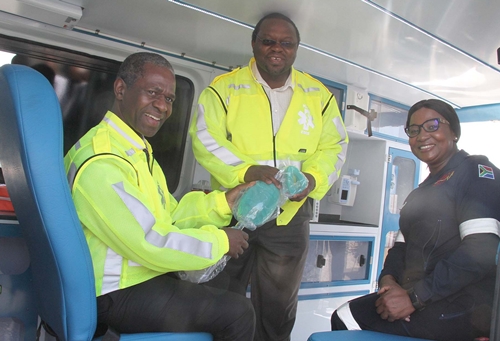

Ladies and gentlemen,
It gives me great pleasure to welcome you to the official handing over of ambulances, just in time before the start of the peak December holiday season, which begins in earnest this coming weekend.
Emergency Medical Services (EMS) is one of the three core pillars in health service delivery, standing as it does alongside primary health care (PHC) and hospital services.
This component is crucial in the attainment of the core outcome of our government which is to ensure “a long and healthy life for all South Africans”. This outcome is measured in four specific areas which are:
We are a Province that is home to more than 10 million people which amounts to 21% of the population of the country. At least 80% of these people depend on public health sector for their medical and health needs.
Our Emergency Medical Service is the largest in the country, operating more than 300 ambulances and having more than 2 500 dedicated paramedics in its employ.
Like other parts of the country, the province of KwaZulu-Natal is besieged by a quadruple burden of diseases, which is characterised by four epidemics; namely TB, alongside HIV and AIDS; high maternal and child mortality; non-communicable diseases (such as cancer, diabetes, obesity, hypertension, among others); and violence, injuries and trauma.
When it comes to our ability to respond to incidents of violence, injuries and trauma as a Department, paramedics play a profoundly critical role in saving lives. For those of you who may not be aware, in the medical fraternity we refer to the “Golden Hour” concept.
This is the first hour after a traumatic injury, when emergency treatment is most likely to be successful. Paramedics are usually the first healthcare professionals to arrive at the scene of accident or a homestead of a sick patient and quickly assess the situation and determine the proper course of action for that individual. It therefore becomes crucial for paramedics to get to the scene of an emergency as close to this “Golden Hour” as possible.
It is also a function of the EMS component to provide medical care to patients while they are being transported to a healthcare facility.
Ambulances are therefore basically a Mobile Emergency Clinic whose personnel are trained to drive it; resuscitate and/or stabilise a patient using sophisticated techniques, equipment and drugs. Everything is done to ensure that the patient maintains his or her condition of stability during the ambulance ride.
However, due to the vastness of our province and the rough terrain of some of our roads, our vehicles accumulate high mileage very quickly, which means that they are subject to extraordinary wear and tear, and reach their sell-by date (250 000km) very quickly.
They constantly need to be repaired and in some cases replaced. And because replacing them does not come cheap, we are sometimes forced to soldier on and continue using them even when they have reached that replacement threshold.
Due to budgetary constraints, we have managed to procure a total of 20 ambulances this time around, at a cost of R15 million. The ambulances that we are handing over are fully equipped to an Intermediate Life Support level, and are in line with the new EMS regulations. They will be distributed to all 11 districts to complement the existing operational fleet during the festive season, and beyond. We see investments in new Ambulances as a means to enhance the working environment for this sector whose nature of work is characterised by emergency and urgency.



As a Department, we always strive to have a sufficient number of ambulances to meet the demand; hence the introduction of these new vehicles. We have a responsibility to our communities and visitors to always offer a high level of pre-hospital care by skilled and dedicated ambulance staff. I therefore wish to emphasise that the 20 ambulances that we are handing over are just for the time being. Early in the next financial year, we will certainly be adding significantly to this fleet.
Lastly, we wish to once again register our shock and dismay whenever ugly incidents occur whereby paramedics get robbed and vehicles get hijacked while en-route to helping people who are in distress. That is always a sign that something is wrong with our society. It is something we must never allow to happen. These vehicles are not “Government property”. They belong to the public. It is therefore up to each and every one of us to alert law enforcement authorities when we witness unsavoury incidents involving EMS vehicles; whether it is paramedics abusing these vehicles; or when we become aware of any plans to damage, hijack or vandalise these vehicles.
So, we are relying on you to safeguard this property, which is made available to assist those requiring emergency medical care during their time of need. It only when that happens that we can successfully deliver on our noble mandate of delivering "a long and healthy life for all South Africans".
I thank you.
This page last edited on
17 January, 2019
The materials on this website may be copied for non-commercial use as long as our copyright notice and website address are included.
Copyright 2014 - All Rights Reserved - KwaZulu-Natal Department of Health Disclaimer Website by KZN Department of Health